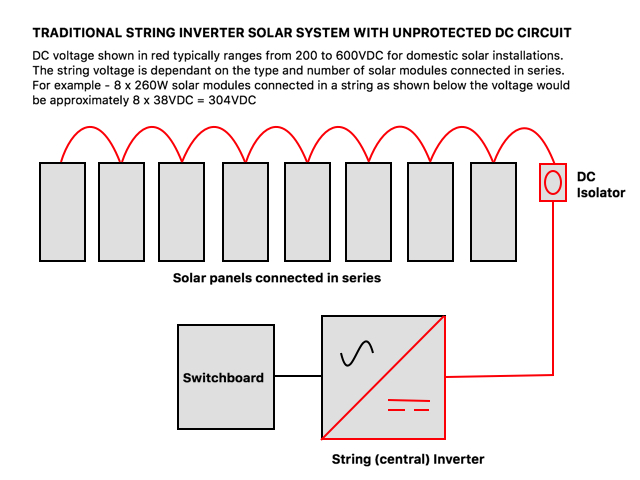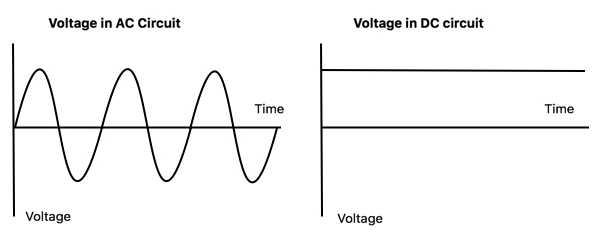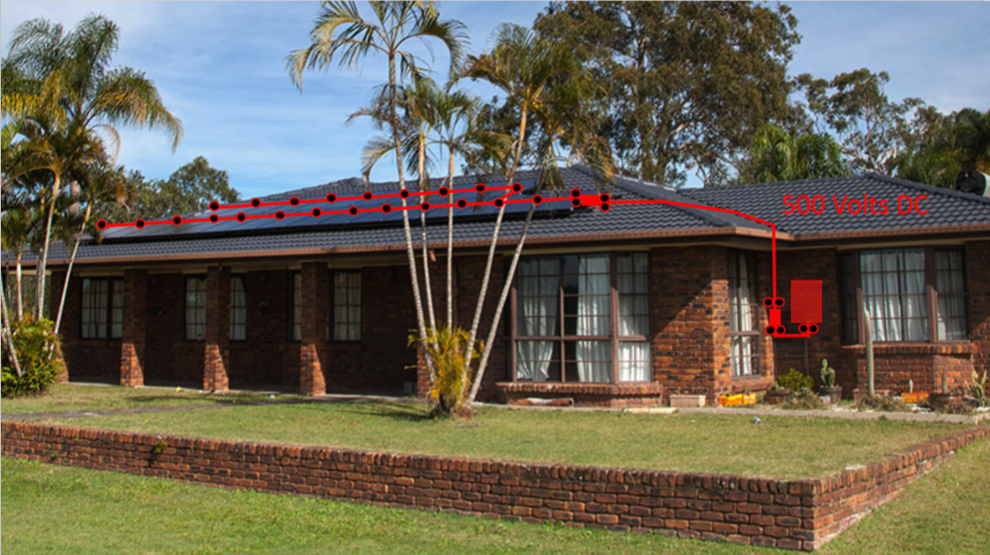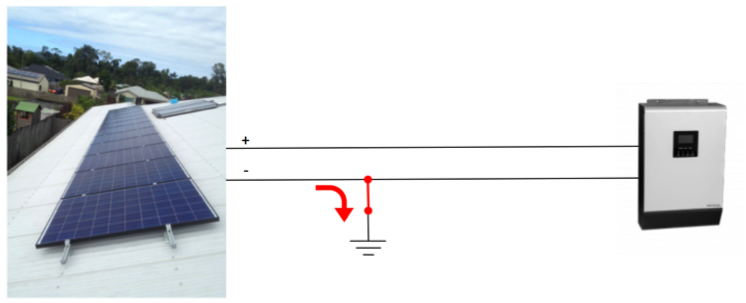What is a DC arc fault?
An arc fault is the flow of electrical energy through an air gap by way of ionized gas molecules. Whilst air is normally regarded as a non-conducting medium, a high potential difference (voltage) between two conductors in close proximity can cause the air molecules to break down into their ionized constituents (called a ‘plasma’), which can then carry a charge from one electrode to the other.The temperature of an electrical arc depends on a number of factors, such as the level of current flow, but on a typical PV system, it is easily hot enough to melt glass, copper and aluminum, and to initiate the combustion of surrounding materials.
DC arc faults occur on the DC cabling of PV solar systems.
Schematic diagram – String inverter solar system with unprotected DC cabling. Cabling, joints and electrical equipment exposed to DC arc faults are shown in red
What does a DC arc fault look like?
4 x 250W solar modules connected in series (1kW). The open circuit DC voltage for this demonstration was only 149.6V DC. The average domestic solar system size in Australia is 3kW to 5kW with DC voltages between 200 and 600V depending on configuration.
Is arcing an issue on AC electrical systems? NO
Arcing is not seen as a common hazard in regular AC electrical systems. This is partly because the electrical industry standards, practices and component designs have evolved over the last 100 years or so to a point whereby modern AC installations are very safe.Arcing is less of an issue in AC systems because AC arcs tend to self-extinguish as the voltage alternates, passing through 0 volts one hundred times per second for standard grid supplies. For an arc to be self-sustaining, the conditions for starting the arc must be present continuously. DC remains at a continuous voltage and once an arc has been established it will continue as long as the DC voltage is present.

Demonstration that DC is a significantly higher fire risk than AC at the same voltage.
Do DC arc faults occur on all solar systems? NO
DC arc faults only occur on string inverter systems that have unprotected DC voltage circuits above approximately 80 volts DC.
DC arc faults do not occur on solar systems that use microinverters and some systems that use DC optimisers that reduce the DC voltage to safe levels in the event of a fault.
Microinverters and DC optimised systems were developed more than 10 years ago to prevent solar fires caused by DC arc faults. These technologies have been readily available in Australia since 2012 so any solar fire that occurs on a solar system installed since 2012 was preventable
Where on the solar system do DC arc faults occur?
Faults can occur anywhere on the DC cabling that runs from the solar modules on the roof to the string inverter which is usually installed adjacent to the main switchboard. There are approximately 26 connections in the DC circuit of a small domestic solar system (2kW) which are effected on site by the solar installer and approximately 50 connections on a 5kW system. All of these connections undertaken by the solar installer is a potential point of failure.There are also additional connections inside the solar modules, DC isolators and the string inverter which are potential points of failure.

What are the types of DC arc faults that occur on solar systems using string inverters?
There are three common types of DC arc faults:Series – A series arc occurs when a connection is broken while the PV is producing current. Any intermittent connection in the DC circuit has the potential for producing a DC arc fault. These connections may include soldered joints within the module, compression type wire connections, connectors used on the wire leads attached to PV modules, connections in DC isolators, connections in the inverter, any DC circuitry in the inverter or any of the DC cabling in the string circuit.

Parallel – Parallel arcs occur when there is a breakdown in the insulation system and current flows between positive and negative. Two conductors of opposite polarity in the same DC circuit are often run in close proximity to each other. The insulation between the two wires can become ineffective due to animals chewing on them, UV breakdown, embrittlement, cracking, moisture ingress and mechanical damage. Parallel arc faults can continue along the conductors towards the array burning materials along the way.

To ground – This fault only requires the failure of one insulation system to ground. This can be the solar module frame, the solar array racking, the roof or any other grounded surfaces.

Often a fault can start out as one type of fault (e.g. series fault) but develop into a different type of fault (e.g. parallel fault).
What can trigger a DC arc fault?
Breakdown of conductor continuity due to:
- Loose joints due to poor installation
- Loose joints due to poor quality connections
- Corrosion of joints over time
Breakdown of insulation system:
- Insulation degradation over time due to UV exposure
- Insulation cracking over time due to changes in temperature (hot – cold)
- Degradation of insulation due to aging
- Damage to insulation by rodents, insects, birds
- Damage to insulation during installation
- Damage to insulation by future building works
- Water ingress to cables, conduits.
- Water ingress to DC isolators from poor installation
- Water ingress to DC isolators due to degradation of seals over time
- Water ingress to inverter
- Water ingress to solar module or junction box
Are DC arc faults something to worry about? YES
DC arc faults have been identified as the root cause of over 400 domestic and commercial building fires in Australia – building fires that risk the safety of occupants and cause damage to property. DC arc faults also cause significant damage to solar equipment.
The highest quality DC cabling components can be selected and installed with the greatest care. However, cable insulation and conductor degradation will occur over time, which can cause a DC arc fault.
If you see or hear a DC arc fault, can switching off your inverter stop the arc? NO
DC arc faults occur on the DC cabling under the solar array, anywhere along the DC cabling from the solar array on the roof to the string inverter and even inside the string inverter. Switching off the inverter does not switch off the DC wiring. The DC wiring from the solar array to the inverter is live whenever the sun is shining and there is no method to isolate this wiring. So switching off the inverter will not quench a DC arc fault. Depending on the location of the fault, operating the roof top DC Isolator may isolate the fault and extinguish the arc, however this will require accessing the roof and locating the appropriate DC isolator. Interrupting a DC arc fault with an isolator is not without its own dangers and would only be considered as a last resort.
Can DC arc faults be prevented? YES
There are a variety of solar technologies that have been available for more than a decade which eliminate the risk associated with DC arc faults. These include microinverters manufactured by companies such as Enphase Energy and AP Systems, and also some DC optimised systems such as SolarEdge, which have a safe DC mode.
Elimination of dangerous DC voltages is a safer approach than implementing control measures such as protection for DC arc faults. There is always a risk that a protection system that is not installed and maintained correctly will not operate when a fault occurs.
Solar technologies are readily available that eliminate the risk of DC arc faults. These technologies have been readily available in Australia since 2012 so any solar fire that occurs on a solar system installed since 2012 was preventable.
Do string inverters with built-in arc fault protection provide protection for all types of DC arc faults? NO
There are some string inverters available now with built-in arc fault detection. However, these DO NOT detect and isolate all types of DC arc faults listed above.
Inverters with built-in arc detection identity a DC arc fault using noise on the DC cabling produced by the arc. Once an arc is detected the DC circuit at the inverter will be isolated. This will extinguish a ‘series’ arc but WILL NOT extinguish a ‘parallel’ or ‘ground’ fault arc. The DC cabling under the solar array and down to the inverter will remain live when the DC circuit is isolated at the inverter. A parallel or earth fault will continue to arc on solar systems using string inverters with DC arc fault protection.
Do rapid shutdown devices on the roof provide protection for all DC arc faults? NO
Rapid shutdown devices are available which can be installed on the roof next to the solar array. These are usually located at the end of string. They are designed to isolate the DC circuit when a DC arc fault is detected. Unfortunately, they do not isolate any faults that occur on the many connections under the solar array or provide protection for ground faults.
Do DC arc faults only occur on DC isolators? NO
There is a common belief among some solar installers that DC arc faults only occur at DC isolators. This is not correct. DC arc faults occur wherever there are joints in the DC cables, a breakdown of cable continuity or a breakdown of insulation. This is occurring on the solar modules, the DC connectors, the DC cabling, the joints in the DC isolators or inside the inverter.
Is removing Rooftop DC isolators an option to reduce DC arc faults? NO
Not installing rooftop DC isolators will certainly eliminate the possibility of them failing in the future. However, basic electrical theory dictates that it is necessary to be able to isolate a generator of electricity as close as possible to the source. For example, if a fault occurs on the DC cabling in the roof cavity or anywhere between the solar modules and the string inverter, the system must be provided with a way of turning off the supply to isolate the fault. If a person was unfortunate enough to come in contact with the DC wiring, standard safe rescue procedure is to isolate the supply before attempting a rescue.
So although removing the rooftop DC isolator may seem like an easy way of preventing them failing, it is not practical to leave the system with no means of isolating the solar array in the event of a fault or accident.
Will removing DC isolators prevent DC arc faults? NO
DC arc faults occur wherever there are joints in the DC cables, a breakdown of cable continuity or a breakdown of cable insulation. If a DC isolator was replaced with a junction box or DC connector marshaling box, faults will continue to occur at this point as well as other points in the DC circuit.
The most effective approach to prevent DC arc faults is to eliminate the presence of dangerous DC voltages using microinverters or the use of some DC optimised systems with safe DC.
Does the likelihood of DC arc faults increase as solar systems with string inverters age? YES
The likelihood of a DC arc fault increases as solar systems age. This is because joints in the DC wiring corrode over time increasing the impedance, causing heat and the breakdown of the continuity of the joint resulting in a DC arc fault. Also, seals on isolators, conduits etc degrade over time allowing water increase which can cause a DC arc fault.
Rodents, insects, birds can damage insulation, future works can damage insulation or insulation can simply degrade over time.
Is it true that so long as a DC solar system is installed in accordance with the Australian Standards (AS5033) and good quality equipment and installation practices are used, then the system is ‘safe’? NO
There have been numerous cases of fires that have started due to equipment that was considered ‘high quality’ at the time it was installed, only to have been recalled by the manufacturer years later due to manufacturing or design defects. Often these defects do not show up until the system has been operating for several years.
Installing solar systems on rooves is a difficult and at times dangerous task, particularly in often hot and uncomfortable conditions. These conditions are not conducive to perfect workmanship, and it only takes a momentary lapse of concentration to not tighten a junction box or DC isolator to the correct torque – which will eventually fail due to water ingress. Practical experience is that even the best tradesman can make mistakes occasionally and with DC systems these mistakes can have catastrophic consequences.
The Australian Standards (particularly AS5033) go to great lengths to try to eliminate all of the likely causes of DC arc faults within a solar system. There are rigorous inspection regimes in place (much more so than any regular electrical installation) and still there are numerous examples of catastrophic DC arc faults occurring on DC solar systems every day in Australia. This alone should answer the question regarding whether following the existing Australian standards is sufficient to eliminate DC arc faults.
The only way to eliminate the risk of DC arc faults is to eliminate the dangerous DC voltage itself from the system or use a technology specifically designed to reduce the system voltage to safe levels in the event of a fault.
Can regular maintenance prevent DC arc faults on solar systems with string inverters and unprotected DC cabling? NO
There is a common belief that if a DC solar system with unprotected medium voltage DC cabling is installed in compliance with Australian Standards AS5033 and regularly maintained it is perfectly safe. This is not true. A solar installer can regularly maintain a solar system. However, even that night after the inspection or any night after the inspection a rodent, possum etc can bite through the insulation of the DC cabling. When the sun rises the solar panels start producing power, the bare conductors become live causing a DC arc fault and building fire. It is practically impossible for a solar installer to check all of the seals are waterproof preventing water ingress and to also check that all of the cable joints are not corroded and subject to high impedance.
There is simply no maintenance program which can prevent a DC arc fault on solar systems with string inverters and unprotected DC cabling.
Does this only occur in Australia? NO
The United States is leading Australia in addressing this problem. In 2014, they introduced via the National Electric Code (NEC), rapid shutdown requirements on solar arrays. This de-energises the DC cable from the roof to the inverter when the system is switched off. While this has helped, incidents of DC arc faults with the solar array have continued so they are now planning to introduce measures this year to limit the maximum DC voltage within arrays to 80V DC or below when the system is shut down. They are taking these measures to also provide improved safety for emergency services and anyone who may come in contact with the solar system.
The United Kingdom have recognized the problem and undertaking a detailed investigation into solar fires caused by DC arc faults.
Examples of DC arc faults






































































